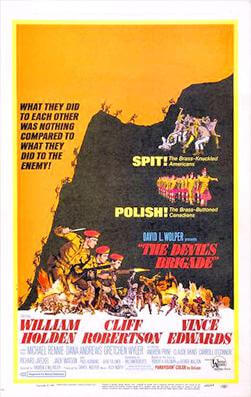
Original film poster for The Devil’s Brigade. [WikiMedia]
He remembers seeing the Americans, portrayed as unruly no-goods, pause mid-brawl as bagpipe-playing Canucks made a memorable entrance.
“A war film in that setting was always thrilling,” Zuehlke recalls, “and I was favourably impressed that it at least depicted Canadians, despite the fact—even to my kid’s mind—they didn’t really seem like anyone I knew.”
His views would be shared by many, both avid moviegoers and those veterans who had belonged to the actual First Special Service Force (FSSF).
The real-life Canada-U.S. unit—members of which were ultimately nicknamed the “Black Devils”—served with distinction through much of the Second World War. Most famously, the elite group of men fought at the Italian Campaign’s Battle of Monte la Difensa after scaling the German-held mountain.
Such death-defying exploits were prime movie material. American producer David L. Wolper would be the first to realize that potential.
On May 14, 1968, The Devil’s Brigade—a heavily dramatized version of events—received a dual premiere at the Vanity Theatre in Windsor, Ont., and the Michigan Theatre in Detroit. The next day—May 15—the film was released to general audiences. It would generate moderate, if muted, praise.
Viewers quickly noted similarities to the cult classic war film The Dirty Dozen, released mere months earlier, even if Wolper’s epic had been in the pipeline long before. The Devil’s Brigade would forever live in its shadow.
“It’s classic American versus Canadian bravado.”
The 56-year-old film still has much to offer fans of thrilling action sequences, state-of-the-art special effects and era-defining tropes. During the course of its 130-minute run time, it takes an ill-matched band of misfits and moulds them into a coherent fighting force.
The Devil’s Brigade stars American William Holden as FSSF commander Robert T. Frederick. Joining him as the ranking Canadian officer is fellow U.S. actor Cliff Robertson—adopting a questionable accent.
Initially, the movie focuses on the perceived rivalries between the two countries. At one stage in early training scenes, the Americans taunt and prank a victimized Canadian corporal. In another, a Canuck hand-to-hand combat instructor makes a public mockery of an arrogant U.S. soldier.
“It’s classic American versus Canadian bravado,” notes historian Ted Barris, who, like Mark Zuehlke, remembers watching the war epic years ago. “I looked at The Devil’s Brigade trailer only recently, and there is a voiceover talking about those same “brass-knuckle” Americans and “brass-button” Canadians. It very much creates, or invents, the animosity between the two sides, when, from my recollection of [FSSF member] interviews, developing a team based on skills and personalities was far more important than nationalities.”
Not only does the on-screen competitiveness come across as exaggerated, but it likewise draws considerable focus to the film’s choice of stereotypes. In lieu of an overtly British presence, the Canadians become rigid, disciplined, stiff-upper-lipped soldiers with little patience for American antics.
Even in the absence of quintessential British personas, notably during the mountain warfare training scene, there are often many different stereotypes ready to take their place. “Canadians are portrayed as natural skiers,” notes Zuehlke, “but thankfully, the men don’t have to carry double-bladed axes and wear lumberjack coats.”
Ultimately, the film’s narrative shifts to the forging of bonds. No longer are Yanks and Canucks at each other’s throats, but ready to take on the Nazis as a well-oiled fighting machine. They get their chance in Italy, even as The Devil’s Brigade glosses over the FSSF’s first operation in Alaska’s Aleutian Islands.
The Battle of Monte la Difensa, which took place Dec. 3-9, 1943, is the film’s culminating event. Though laced with near-countless historical inaccuracies, audiences of 1968 found it a satisfying final act.
“The action sequences—recognizing they didn’t have digital animation—are pretty raw, and the stunts pretty fantastic for their day,” said Ted Barris. “Yet I find so many of those films done in colour in the 1960s are too vivid. Perhaps The Devil’s Brigade might have been better off in black and white, although I think Hollywood and American viewers demanded colour by that time.”
For audiences north of the border, meanwhile, there was, and is, one thing most could agree on: The surprise at Canadians being portrayed at all.
Canada’s wartime story was—and in many respects still is—misrepresented or entirely disregarded on the big screen.
In the years immediately following the Second World War, U.S.- and U.K.-made war films became a cultural phenomenon that often, if not always, touted their own respective achievements during the conflict. Between 1946 and 1959 alone, no fewer than 85 British war films enthralled cinema crowds. Many more, of course, originated from well-funded American producers and directors.
Inevitably, Canada’s wartime story was—and in many respects still is—misrepresented or entirely disregarded on the big screen.
In 1962’s three-hour epic The Longest Day, the Canadian landings on Juno Beach are marginalized in the overarching D-Day narrative.
In 1963’s classic The Great Escape, the real-life exploits of Canadian prisoners are all but erased, instead replaced with different Allied characters—a slight Ted Barris has tackled in his book The Great Escape: A Canadian Story.
Even the 2020 Dutch-made film, The Forgotten Battle, uses Canada’s Scheldt Campaign to develop non-Canadian characters.
Yet not all of the blame can be laid at these international filmmakers’ doors, suggests the Canadian War Museum’s Chief Historian Tim Cook: “In my book The Fight For History, I argue that Canada has strangely ignored its Second World War achievements and veterans until quite recently, and that Canadians must do a better job at presenting their history on film, in magazines, in books, in museums, and in all places where Canadians and Americans consume their history. If we don’t tell that story, no one else will.”
Despite this, Cook, like Zuehlke and Barris, has a soft spot for The Devil’s Brigade: “It is a rousing wartime adventure that I find repays with each viewing. Over the years, veterans have told me they also enjoyed the film. One chuckled with pleasure and said he remembered it differently, however. Indeed.”
Advertisement






















